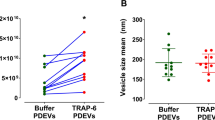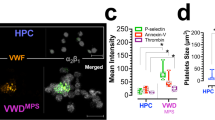Abstract
Background
Platelets are blood cells responsible for the prevention of blood loss upon vessel wall disruption. It has been demonstrated that platelet functioning differs significantly between adult and pediatric donors. This study aimed to identify potential differences between the protein composition of platelets of pediatric, adolescent, and adult donors.
Methods
Platelet functional testing was conducted with live cell flow cytometry. Using a straightforward approach to platelet washing based on the sequential platelets centrifugation-resuspension, we were able to obtain stable and robust proteomics results, which corresponded to previously published data.
Results
We have identified that pediatric donors’ platelets have increased amounts of proteins, responsible for mitochondrial activity, proteasome activity, and vesicle transport. Flow cytometry analysis of platelet intracellular signaling and functional responses revealed that platelets of the pediatric donors have diminished granule secretion and increased quiescent platelet calcium concentration and decreased calcium mobilization in response to ADP. We could explain the observed changes in calcium responses by the increased mitochondria protein content, and the changes in granule secretion could be explained by the differences in vesicle transport protein content.
Conclusions
Therefore, we can conclude that the age-dependence of platelet functional responses originates from the difference in platelet protein content.
Impact
-
Platelets of infants are known to functionally differ from the platelet of adult donors, although the longevity and persistivity of these differences are debatable.
-
Pediatric donor platelets have enhanced amounts of mitochondrial, proteasomal, and vesicle transport proteins.
-
Platelets of the pediatric donors had increased cytosolic calcium in the resting state, what is explained by the increased numbers of mitochondrial proteins. Infants had decreased platelet granule release, which resolved upon adolescence. Thus, platelets of the infants should be assessed differently from adult platelets.
-
Differences in platelet proteomic contents persisted in adolescent groups, yet, no significant differences in platelet function were observed.
This is a preview of subscription content, access via your institution
Access options
Subscribe to this journal
Receive 14 print issues and online access
$259.00 per year
only $18.50 per issue
Buy this article
- Purchase on Springer Link
- Instant access to full article PDF
Prices may be subject to local taxes which are calculated during checkout





Similar content being viewed by others
Data availability
The datasets generated during and/or analyzed during the current study are available from the corresponding author upon reasonable request.
References
Sveshnikova, A. et al. Platelet functional responses and signalling: the molecular relationship. Part 1: responses. Syst. Biol. Physiol. Rep. 1, 20 (2021).
Panteleev, M. A. & Sveshnikova, A. N. Platelets and hemostasis. Oncohematology 9, 65–73 (2014).
Cuenca-Zamora, E. J., Ferrer-Marín, F., Rivera, J., Teruel-Montoya, R. Tubulin in platelets: when the shape matters. Int. J. Mol. Sci. 20. https://doi.org/10.3390/ijms20143484 (2019).
Gao, J. et al. Kindlin supports platelet integrin αIIbβ3 activation by interacting with paxillin. J. Cell Sci. 130, 3764–3775 (2017).
Deppermann, C. et al. Platelet secretion is crucial to prevent bleeding in the ischemic brain but not in the inflamed skin or lung in mice. Blood 129, 1702–1706 (2017).
Podoplelova, N. A., Nechipurenko, D. Y., Ignatova, A. A., Sveshnikova, A. N. & Panteleev, M. A. Procoagulant platelets: mechanisms of generation and action. Hämostaseologie 41, 146–153 (2021).
Dale, G. L. Coated-platelets: an emerging component of the procoagulant response. J. Thromb. Haemost. 3, 2185–2192 (2005).
Hézard, N. et al. Unexpected persistence of platelet hyporeactivity beyond the neonatal period: a flow cytometric study in neonates, infants and older children. Thromb. Haemost. 90, 116–123 (2003).
Herken, K. et al. Age-dependent control of collagen-dependent platelet responses by thrombospondin-1-comparative analysis of platelets from neonates, children, adolescents, and adults. Int J. Mol. Sci. 22, 4883 (2021).
Yip, C., Linden, M. D., Attard, C., Monagle, P. & Ignjatovic, V. Platelets from children are hyper-responsive to activation by thrombin receptor activator peptide and adenosine diphosphate compared to platelets from adults. Br. J. Haematol. 168, 526–532 (2015).
Ignatova, A. A. et al. Flow cytometry for pediatric platelets. Platelets 30, 428–437 (2019).
Blair, P. & Flaumenhaft, R. Platelet α–granules: basic biology and clinical correlates. Blood Rev. 23, 177–189 (2009).
McNicol, A. & Israels, S. J. Platelet dense granules: structure, function and implications for haemostasis. Thromb. Res. 95, 1–18 (1999).
Tesfamariam, B. Distinct characteristics of neonatal platelet reactivity. Pharmacol. Res. 123, 1–9 (2017).
Davenport, P. & Sola‐Visner, M. Platelets in the neonate: not just a small adult. Res Pr. Thromb. Haemost. 6, e12719 (2022).
Urban, D. et al. Decreased numbers of dense granules in fetal and neonatal platelets. Haematologica 102, e36–e38 (2017).
Hvas, A.-M. & Favaloro, E. J. Platelet function testing in pediatric patients. Expert Rev. Hematol. 10, 281–288 (2017).
Yip, C. & García, Á. Exploring the potential of platelet proteomics in children. Prot. Clin. Appl. 8, 807–812 (2014).
Stokhuijzen, E. et al. Differences between platelets derived from neonatal cord blood and adult peripheral blood assessed by mass spectrometry. J. Proteome Res. 16, 3567–3575 (2017).
Sveshnikova, A. N. et al. Systems biology insights into the meaning of the platelet’s dual-receptor thrombin signaling. J. Thromb. Haemost. 14, 2045–2057 (2016).
Best, M. G. et al. RNA-Seq of tumor-educated platelets enables blood-based pan-cancer, multiclass, and molecular pathway cancer diagnostics. Cancer Cell 28, 666–676 (2015).
Schwanhäusser, B. et al. Global quantification of mammalian gene expression control. Nature 473, 337–342 (2011).
Tyanova, S., Temu, T. & Cox, J. The MaxQuant computational platform for mass spectrometry-based shotgun proteomics. Nat. Protoc. 11, 2301–2319 (2016).
Farrah, T. et al. A high-confidence human plasma proteome reference set with estimated concentrations in PeptideAtlas. Mol. Cell Proteom. 10, M110.006353 (2011).
Bryk, A. H. & Wiśniewski, J. R. Quantitative analysis of human red blood cell proteome. J. Proteome Res 16, 2752–2761 (2017).
Martyanov, A. A. et al. Heterogeneity of Integrin αIIbβ3 function in pediatric immune thrombocytopenia revealed by continuous flow cytometry analysis. Int J. Mol. Sci. 21, E3035 (2020).
Grynkiewicz, G., Poenie, M. & Tsien, R. Y. A new generation of Ca2+ indicators with greatly improved fluorescence properties. J. Biol. Chem. 260, 3440–3450 (1985).
Martyanov, A. A. et al. Longitudinal multiparametric characterization of platelet dysfunction in COVID-19: effects of disease severity, anticoagulation therapy and inflammatory status. Thromb. Res 211, 27–37 (2022).
Burkhart, J. M. et al. The first comprehensive and quantitative analysis of human platelet protein composition allows the comparative analysis of structural and functional pathways. Blood 120, e73–e82 (2012).
Stalker, T. J. Platelet activation gradients during thrombus formation. Blood 126, SCI-13 (2015).
Colberg, L., Cammann, C., Greinacher, A. & Seifert, U. Structure and function of the ubiquitin‐proteasome system in platelets. J. Thromb. Haemost. 18, 771–780 (2020).
El-Kadiry, A. E.-H. & Merhi, Y. The role of the proteasome in platelet function. Int. J. Mol. Sci. 22, 3999 (2021).
Montague, S. J., Andrews, R. K. & Gardiner, E. E. Mechanisms of receptor shedding in platelets. Blood 132, 2535–2545 (2018).
Huang, J. et al. Molecular proteomics and signalling of human platelets in health and disease. IJMS 22, 9860 (2021).
Tassi Yunga, S. et al. Effects of ex vivo blood anticoagulation and preanalytical processing time on the proteome content of platelets. J. Thromb. Haemost. 20, 1437–1450 (2022).
Lehallier, B. et al. Undulating changes in human plasma proteome profiles across the lifespan. Nat. Med. 25, 1843–1850 (2019).
Eshel-Green, T., Berny, M., Conley, R. & McCarty, O. Effect of sex difference on platelet adhesion, spreading and aggregate formation under flow. Thromb. Haemost. 102, 958–965 (2009).
Soo Kim, B., et al. Sex-specific platelet activation through protease-activated receptors reverses in myocardial infarction. ATVB https://doi.org/10.1161/ATVBAHA.120.315033 (2020).
Jayachandran, M. et al. Sex-specific changes in platelet aggregation and secretion with sexual maturity in pigs. J. Appl Physiol. (1985) 97, 1445–1452 (2004).
Cini, C. et al. Differences in the resting platelet proteome and platelet releasate between healthy children and adults. J. Proteom. 123, 78–88 (2015).
Luo, S.-Z., Mo, X., López, J. A. & Li, R. Role of the transmembrane domain of glycoprotein IX in assembly of the glycoprotein Ib-IX complex. J. Thromb. Haemost. 5, 2494–2502 (2007).
Mo, X., Liu, L., López, J. A. & Li, R. Transmembrane domains are critical to the interaction between platelet glycoprotein V and glycoprotein Ib-IX complex: GPV and GPIb-IX interaction. J. Thromb. Haemost. 10, 1875–1886 (2012).
Modderman, P. W., Admiraal, L. G., Sonnenberg, A., von dem Borne, A. E. Glycoproteins V and Ib-IX form a noncovalent complex in the platelet membrane. J. Biol. Chem. 267, 364–369 (1992).
Funding
Platelet proteomics assays (Figs. 1, 2, Supplementary materials) were funded by Russian Science Foundation, grant number 21-74-20087; proteomics data analysis (Fig. 3) was funded by Russian Science Foundation, grant number 23-74-00057; platelet functional and signaling analysis (Figs. 4, 5) was funded by the endowment foundation “Science for Children”.
Author information
Authors and Affiliations
Contributions
A.K.G.D. analyzed data, prepared samples for proteomics analysis, and wrote text; A.A.M. performed intracellular signaling assays, prepared samples for proteomics, analyzed flow cytometry data, wrote the text and edited the paper; A.A.I. performed platelet functional testing; V.G.Z. performed proteomics assays and analyzed proteomics data; G.A.N. analysed hematological status of the donors and edited the paper; M.A.P. analyzed proteomics and platelet functional data; A.N.S. recruited the resources for the study, conceptualized the project, analyzed the data, edited the paper and supervised the study.
Corresponding author
Ethics declarations
Competing interests
The authors declare no competing interests.
Ethics approval
The study was conducted in accordance with the Declaration of Helsinki, and approved by the Institutional Review Board (or Ethics Committee) of CTP PCP RAS (protocol code 2 06.04.2021)
Informed consent
Informed consent was obtained from each of the included donors or their legal representatives.
Additional information
Publisher’s note Springer Nature remains neutral with regard to jurisdictional claims in published maps and institutional affiliations.
Supplementary information
Rights and permissions
Springer Nature or its licensor (e.g. a society or other partner) holds exclusive rights to this article under a publishing agreement with the author(s) or other rightsholder(s); author self-archiving of the accepted manuscript version of this article is solely governed by the terms of such publishing agreement and applicable law.
About this article
Cite this article
Garzon Dasgupta, A.K., Martyanov, A.A., Ignatova, A.A. et al. Comparison of platelet proteomic profiles between children and adults reveals origins of functional differences. Pediatr Res 95, 966–973 (2024). https://doi.org/10.1038/s41390-023-02865-y
Received:
Revised:
Accepted:
Published:
Issue Date:
DOI: https://doi.org/10.1038/s41390-023-02865-y



